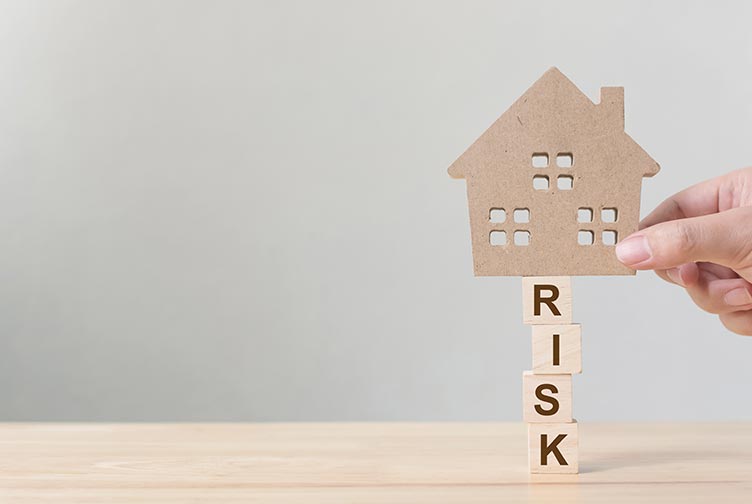
Most investments come with some degree of risk. Generally speaking, the greater the risk, the higher the return requirements on your investment.
The factors that determine risk in your commercial real estate investments are much different than the factors that constitute risk in the stock market, however. Market risk is dictated by macro issues such as recessions, national economic growth, inflation, and fluctuating interest rates. Unpredictable volatility, such as a global pandemic or terrorist attacks that shut down the country’s economic engines, also can increase investor risk.
Risk in commercial real estate, meanwhile, involves issues such as asset classes, market demographics, property types, tenant liquidity, and credit. Below we’ll take a closer look at three factors that can increase the risk profile or potentially impact returns on your commercial real estate investments.
Real Estate Risk and Property Type
Commercial assets perform differently -- and some can be riskier than others. Take retail properties or retail-anchored strip centers as an example. Brick-and-mortar retail ground to a halt in 2020 due to the coronavirus and ensuing government-mandated shutdowns. E-retailers, meanwhile, were going gangbusters as self-isolated shoppers turned to the internet in droves. This growth has proved beneficial for industrial warehousing, creating a gulf that has widened throughout the year. Longtime brick-and-mortar retailers such as Brooks Brothers, Lucky, GNC, Pier 1, and many others filed for bankruptcy in 2020. Conversely, Amazon, the world’s largest e-retailer, saw its share price skyrocket in the past three quarters. Amazon started the year trading around $1,800, but by September, its stock was north of $3,500.
The commercial office sector, meanwhile, has seen a mass transition to working remotely. Nationwide office vacancy stood at 11.5 percent early this year, Colliers International reports. However, office vacancy in certain markets, such as Silicon Valley and Seattle, is much lower, Colliers notes. Much of the impact on the office sector has been in leasing volumes, which dropped significantly due to pandemic, while demand for new office space has virtually stopped in many markets. However, since office leases are typically long-term lease structures (i.e., 10 years), tenants continue to pay rents, and there have been few reported issues on rent collections.
Multifamily, meanwhile, has seen a slight uptick in vacancy rates due to Covid-19, but the sector overall is still outperforming, CBRE reports.
Key takeaway: When considering potential like-kind properties to complete a 1031 exchange, investors should take a close look at the performance of the property type, as well as tenant mix, lease structures, asset condition, and location.
Real Estate Risk and Location
With some commercial assets, location is one of the most important factors to consider. However, location also can be fickle. Cities are constantly evolving and growing, and today’s prime areas for retail, office, or multi-family properties might not be as desirable in 10 or 20 years.
Geography can heavily influence valuations for commercial properties as well. Primary markets -- New York, Los Angeles, San Francisco -- benefit from large and diverse economies that can insulate these cities from the cyclical economic downturns that erode property valuations. Investors pay for that stability in core markets through higher valuations since they usually pose less risk.
Properties in secondary and tertiary markets, meanwhile, tend to be more susceptible to swings in regional and national economies. While valuations in these markets offer investors the potential for greater returns, they can also pose greater risk.
Key takeaway: Due to their fixed location, commercial assets can be vulnerable to environmental or geographical concerns, as well as desirability and changing urban/suburban demographics. These factors can create negative pressure on equity and increase risk.
Real Estate Risk and Tenant Credit
Properly evaluating tenant creditworthiness, or tenants’ ability to continue meeting their lease obligations, can mitigate risk in commercial real estate investments. This is essential when considering single-tenant leased properties for like-kind replacements, since your revenue stream evaporates if that tenant defaults on their rent.
Rated companies with strong brand recognition, such as Apple or Tesla, have strong balance sheets and pose minimal risk since there’s less chance of them defaulting. The same goes for many national eateries, drugstores, and the like. It can be harder for investors to gauge credit risk for non-rated tenants; however, if you can get a better feel for a tenant’s creditworthiness and risk potential by doing the following:
- Review all pertinent business financials, payment, and rental histories
- Assess the tenant’s strength and position within their industry
- Tenant’s business acumen
Even if you’ve asked the hard questions above, it might be time to revisit them during these unsettled economic times. The better you can minimize risk across your commercial investment portfolio, the more confidence you’ll have in your investment decisions, as well as potentially realize greater returns.



